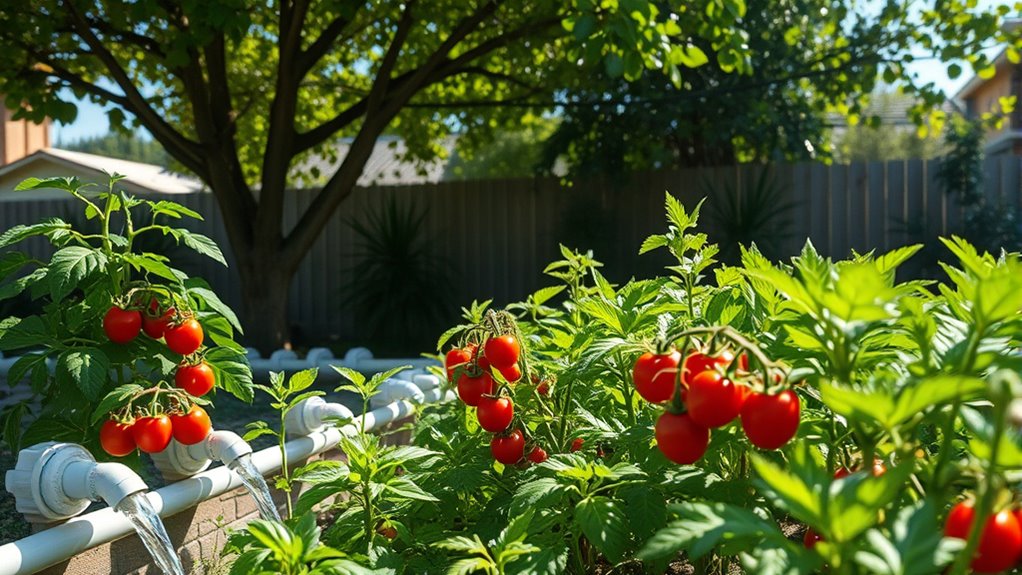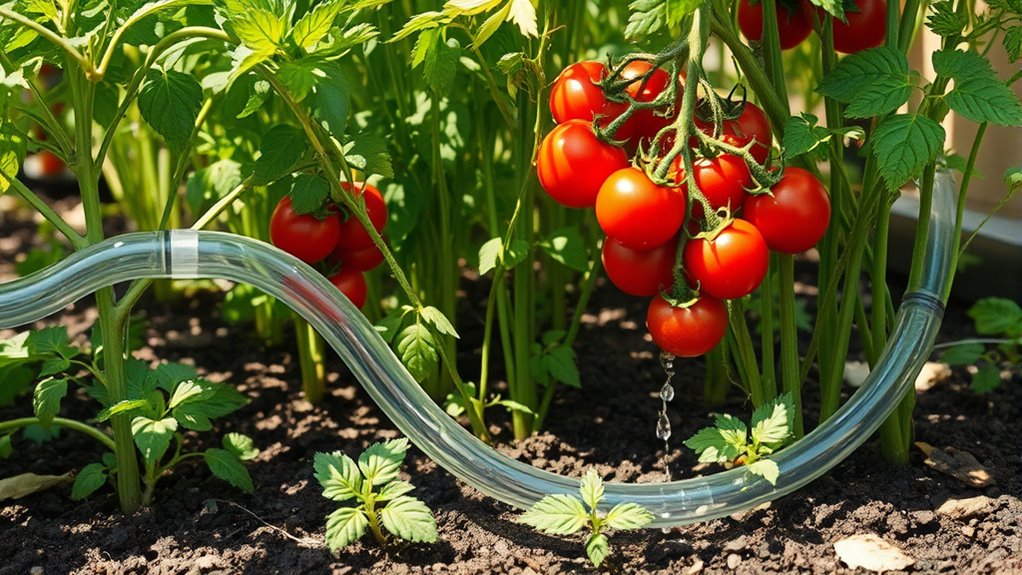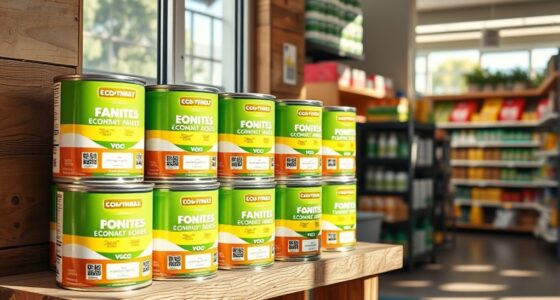Using greywater from your shower to water your tomatoes is an eco-friendly way to save water and nourish your garden. It recycles water that contains beneficial nutrients, reducing your utility bills and easing the load on local wastewater systems. Just be sure to avoid harmful chemicals like bleach and use biodegradable soaps. Properly designed systems make this process safe and effective. Keep exploring to discover more tips on sustainable gardening with greywater.
Key Takeaways
- Reusing shower greywater provides beneficial nutrients to tomato plants, promoting healthy growth.
- Proper system design ensures greywater is safely directed to garden beds without harmful chemicals.
- Biodegradable, plant-friendly soaps are essential for safe greywater reuse on edible plants like tomatoes.
- Greywater systems reduce household water use and decrease load on municipal wastewater treatment.
- Reusing shower water supports sustainable gardening and stormwater management by reducing runoff and pollution.

Have you considered how greywater systems can reduce your household water usage? By recycling water from your shower, you not only cut down on your utility bills but also contribute to better stormwater management and wastewater treatment. Instead of letting used water go down the drain and into the sewer system, greywater systems allow you to reuse it for outdoor purposes like watering plants or gardening. This practice helps alleviate the load on municipal wastewater treatment facilities and reduces the risk of stormwater runoff overloads during heavy rains.
When you use greywater for watering your tomatoes, you’re actively participating in sustainable water management. Shower water contains nutrients that are beneficial for plants, making it an excellent resource for your garden. Installing a greywater system is straightforward — it captures water from your shower drain and directs it to your garden beds through a controlled system. This approach minimizes the amount of freshwater needed for gardening and diminishes the volume of wastewater that needs to be treated. It’s essential, however, to ensure that the greywater is free of harmful chemicals like bleach or harsh soaps, which can harm plants or contaminate soil. Using biodegradable, plant-friendly soaps makes the process safe and environmentally friendly.
Implementing a greywater system also supports stormwater management by reducing runoff during storms. When excess rainwater mixes with household greywater, it can overwhelm drainage systems, causing flooding and water pollution. Properly designed greywater systems help absorb and reuse water on-site, decreasing the amount of stormwater that enters municipal systems and reducing the strain on wastewater treatment plants. This local reuse helps prevent water pollution and promotes healthier waterways. Plus, it’s an effective way to make your household more resilient to droughts and water shortages.
Additionally, understanding the potential for emotional abuse in personal relationships can help you recognize warning signs early and seek appropriate support. By reusing shower water for your tomato plants, you’re closing the water loop in a practical way. It’s a simple step that benefits your garden and the environment. You reduce your reliance on external water sources and lessen the burden on stormwater management infrastructure. When wastewater treatment plants process less household greywater, they can operate more efficiently, saving energy and resources. This integrated approach emphasizes sustainability, showing how everyday actions can have a positive impact beyond your home.
In essence, greywater systems offer a smart solution to water conservation and environmental protection. They enable you to reuse water responsibly, support stormwater management efforts, and ease the pressure on wastewater treatment facilities. Growing tomatoes with shower water becomes not just a gardening choice but a meaningful step toward a more sustainable lifestyle.
Frequently Asked Questions
What Are the Legal Regulations for Greywater Reuse in My Area?
You need to check the legal regulations in your area to guarantee legal compliance with greywater reuse. Regional restrictions often vary, so it’s vital to research local laws or consult with authorities before installing a greywater system. By understanding these regulations, you can avoid fines or legal issues. Always prioritize proper system design and maintenance to meet safety standards and promote sustainable water use in your gardening efforts.
How Often Should I Clean or Maintain My Greywater System?
Imagine your greywater system as a garden hose; regular maintenance keeps it flowing smoothly. For ideal system maintenance, you should clean your greywater system at least once every three to six months, depending on usage. Regular cleaning prevents clogs and bacterial buildup. For example, a homeowner who maintains their system quarterly reports fewer issues and healthier plants, highlighting the importance of consistent cleaning frequency.
Can Greywater Be Used for Other Edible Plants Besides Tomatoes?
You can definitely use greywater for other edible plants besides tomatoes. Consider alternative plant options like herbs, leafy greens, and strawberries. To do this safely, you should implement proper greywater filtration techniques, such as biological or physical filters, to remove contaminants. This guarantees your plants stay healthy and safe to eat. Just remember to avoid using greywater on root vegetables or plants consumed raw, for safety reasons.
What Are the Potential Health Risks of Reusing Shower Water?
You should know that reusing shower water can pose health risks if you’re not careful. Pathogen risks are a concern, especially if the water contains bacteria or viruses from human waste. Chemical contamination from soaps, shampoos, or cleaning products can also be present, potentially harming plants or people. To minimize these risks, use proper filtration and avoid harsh chemicals, making sure the greywater is safe before irrigation.
How Much Water Can I Realistically Save With a Greywater System?
You can save a significant amount of water by implementing greywater systems, especially when combined with rainwater harvesting and other water conservation techniques. Depending on your household size and usage, you might save up to 30-50% of your water. Using greywater for gardening reduces your reliance on municipal water, helping conserve resources. With proper system setup, you’ll see tangible savings while supporting sustainable practices in your home.
Conclusion
By embracing greywater systems, you’re opening a door to a greener garden, turning your shower’s runoff into a nourishing river for your tomatoes. Think of it as forging a personal oasis where waste transforms into life. Every drop you reuse is a step toward sustainability, like planting seeds for a future where your garden flourishes with less impact. Start today, and watch your garden bloom as beautifully as a well-tended dream.









